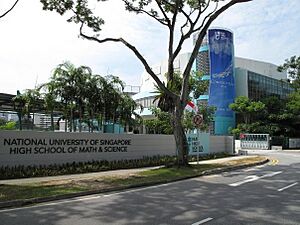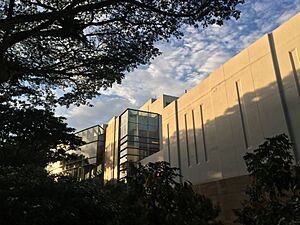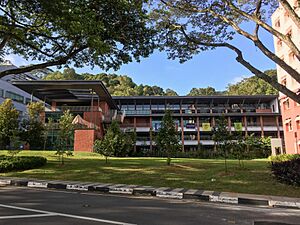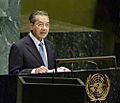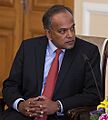National University of Singapore facts for kids
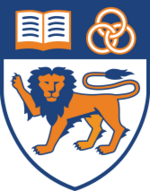
|
|
|
Former names
|
Straits Settlements and Federated Malay States Government Medical School (1905–1921) King Edward VII College of Medicine (1921–1949) University of Malaya, Singapore campus (1949–1962) University of Singapore (1962–1980) Nanyang University (1956–1980) |
|---|---|
| Type | Public research university |
| Established | 3 July 1905 (as King Edward VII College of Medicine) 8 August 1980 (as National University of Singapore) |
|
Academic affiliations
|
ACU, IARU, APRU, Universitas 21, GEM4, AUN, ASAIHL, APSIA, UAiTED |
| Endowment | S$6.46 billion (2020) (US$4.81 billion) |
| Chancellor | President of Singapore |
| President | Tan Eng Chye |
| Provost | Aaron Thean |
|
Academic staff
|
2,555 (2018) |
| Students | 35,908 (2018) |
| Undergraduates | 27,604 |
| Postgraduates | 8,304 |
| Location |
Queenstown, Singapore
1°17′44″N 103°46′36″E / 1.29556°N 103.77667°E |
| Campus | Urban, 150 ha (370 acres) |
| Colours | NUS Orange, NUS Blue |
 |
|
The National University of Singapore (NUS) is a big public research university in Singapore. It was officially created in 1980. This happened when two older universities, the University of Singapore and Nanyang University, joined together.
NUS offers many different study programs for students. These include subjects like science, medicine, law, arts, engineering, business, and music. The main campus of NUS is in Queenstown, near Kent Ridge. There are also other campuses for specific schools, like the Duke–NUS Medical School in Outram and the Faculty of Law in Bukit Timah. Many smart people, including Nobel Prize winners, have taught or studied at NUS.
Contents
History of NUS
The idea for a medical school in Singapore started in 1904. A leader named Tan Jiak Kim asked the governor to create one. People in the community raised money to help. On July 3, 1905, the medical school officially opened. It was first called the Straits Settlements and Federated Malay States Government Medical School.
In 1912, the school received a large donation from the King Edward VII Memorial Fund. Because of this, its name changed to King Edward VII Medical School in 1913. Later, in 1921, it became the King Edward VII College of Medicine. This new name showed that it was a proper college.
In 1928, another school called Raffles College was started. It focused on arts and social sciences.
Joining Forces: University of Malaya
On October 8, 1949, Raffles College and King Edward VII College of Medicine combined. They formed the University of Malaya. This merger helped provide more higher education for the region.
The University of Malaya grew very quickly. By 1959, it had two main parts: one in Singapore and one in Kuala Lumpur.
New Universities in Singapore
In 1955, Nanyang University (also known as Nan-tah) was created. It was important for the Chinese community in Singapore.
In 1960, the governments decided to make the two parts of the University of Malaya into separate national universities. So, on January 1, 1962, the Singapore part became the University of Singapore.
How NUS Was Formed
The National University of Singapore (NUS) was finally created on August 6, 1980. This happened when the University of Singapore and Nanyang University merged. The government wanted to combine their resources to make one strong university. They also wanted to encourage English as the main language for education in Singapore. The old symbol of Nanyang University, with three rings, became part of the new NUS symbol.
Most of the university's departments moved to the Kent Ridge campus. This move started in 1969 and finished in 1986. NUS also began to focus on helping students become entrepreneurs (people who start their own businesses) in the 1980s.
Today, NUS has 17 different schools and faculties. They are spread across three campuses in Singapore: Kent Ridge, Bukit Timah, and Outram. NUS also works with many famous universities around the world, like Harvard University and Yale University. Many students and teachers at NUS come from different countries. This makes NUS a very diverse place.
NUS Symbol: Coat of Arms
The symbol, or coat of arms, of the National University of Singapore was chosen in 1980. It was updated in 2001. It combines symbols from the University of Singapore and Nanyang University.
The symbol shows a lion, an open book, and three interlocking rings.
- The lion represents NUS as a university in Singapore.
- The open book stands for knowledge.
- The three rings show the university's goals: creating new knowledge, sharing it, and using it in real life. They also represent creativity, new ideas, and starting businesses.
NUS is one of two public universities in Singapore that has its own coat of arms. The other is Nanyang Technological University.
University Rankings
| University rankings | |
|---|---|
| Global – Overall | |
| ARWU World | 68 (2024) |
| QS World | 8 (2026) |
| THE World | 17 (2025) |
| THE Reputation | 19 (2025) |
| USNWR Global | 22 (2024) |
| Regional – Overall | |
| QS Asia | 1 (2025) |
| THE Asia | 3 (2023) |
| USNWR Asia | 2 (2024) |
How NUS Ranks Globally
NUS is known as one of the top universities in the world.
- It was ranked 8th globally by QS World University Rankings for 2026.
- It was 17th in the Times Higher Education (THE) World University Rankings for 2025.
- It also ranked 22nd in the USNWR Best Global Universities Rankings for 2024–2025.
- In the Academic Ranking of World Universities (ARWU) for 2024, NUS was 68th.
NUS has been in the top 15 worldwide by QS since 2016. THE has ranked NUS among the top 30 globally since 2013. NUS was also named the world's 10th most international university by THE in 2023. Many NUS researchers are listed among the world's top 2% scientists by Stanford University.
Top Subjects at NUS
NUS is highly ranked in many specific subjects.
- In 2024, QS World University Rankings by Subject placed NUS in the global top 10 for 19 different subjects.
- For example, it ranked 14th globally for its Global Executive MBA program in 2024.
- In the 2024 Times Higher Education (THE) World University Rankings by Subject, NUS was 11th in Computer Science and 9th in Engineering. It was also 11th in Law and 15th in Business & Economics. For all these subjects, NUS was the top university in Singapore.
- The 2023 Academic Ranking of World Universities (ARWU) showed NUS in the global top 30 for 22 subjects.
NUS's Business School also performs well in the Financial Times rankings. For example, its EMBA program was ranked 11th globally in 2022.
Getting a Job After Graduation
NUS graduates are highly sought after by employers.
- In 2022, NUS graduates ranked 8th worldwide in the Times Higher Education's Global University Employability Ranking.
- They also ranked 17th worldwide in the QS Graduate Employability Rankings for 2022.
How NUS is Organized
NUS uses a system where undergraduate courses are divided into semesters and modules. It combines ideas from both British and American education systems. This means students have regular lectures and also smaller group discussions called tutorials. NUS has 17 faculties and schools, including a music school.
Special Programs
- NUS College: This is a special program for top students. It focuses on global citizenship and includes exchange programs in Southeast Asia. It was formed by combining the University Scholars Programme (USP) and Yale-NUS.
Faculties and Schools
NUS has many different schools where students can study specific subjects.
Business
The NUS Business School started in 1965. Today, it has many teachers and thousands of students.
Computing
The School of Computing opened in 1998. It has departments for Computer Science and Information Systems and Analytics.
Dentistry
The Faculty of Dentistry began in 1929. It offers a four-year program to become a dentist.
Design and Engineering
The College of Design and Engineering (CDE) was created in 2021. It brought together the School of Design and Environment (SDE) and the Faculty of Engineering (FoE). The Faculty of Engineering is the largest school at NUS.
Humanities and Sciences
The College of Humanities and Sciences (CHS) was formed in 2020. It includes the Faculty of Arts and Social Sciences and the Faculty of Science.
- The Faculty of Arts and Social Sciences offers many subjects like English, History, and Economics. It also teaches 13 different languages.
- The Faculty of Science has many departments for natural and applied sciences.
Law
The NUS Faculty of Law started in 1956. It moved to the Kent Ridge campus in 1980 but returned to the Bukit Timah campus in 2006. It offers various law degrees.
Medicine
The Yong Loo Lin School of Medicine started in 1905. It offers a program to become a doctor. It also has programs for nursing and other medical sciences.
Duke–NUS Medical School
The Duke–NUS Medical School is a graduate medical school. It was set up in 2005. It's a partnership between Duke University in the US and NUS.
Music
The Yong Siew Toh Conservatory of Music (YSTCM) is Singapore's first music conservatory. It started in 2001. It was renamed after a generous gift from the family of Dr. Yong Loo Lin.
Public Health
The Saw Swee Hock School of Public Health is Singapore's only school for public health. It started in 1948.
Public Policy
The Lee Kuan Yew School of Public Policy was established in 2004. It teaches about public policy and works with Harvard University.
Yale-NUS College
The Yale-NUS College was a special college started in 2013. It was a joint project between Yale University and NUS. It was an independent college within NUS. Students who graduated received a degree from NUS.
In August 2021, NUS announced that Yale-NUS College would merge with the University Scholars Programme to form the new NUS College. The last group of students for Yale-NUS College started in 2021. The college will continue to operate until all its students have graduated.
Teaching and Research Centres
NUS has many centres that help with teaching and learning. These include:
- Centre for Development of Teaching and Learning (CDTL)
- Centre for Instructional Technology (CIT)
- Centre for English Language Communication (CELC)
- Institute of Systems Science (ISS), which offers IT training.
NUS High School of Mathematics and Science
This is a special school for students who are very good at math and science. It provides education for secondary and pre-university students.
Research at NUS
NUS focuses on research in many important areas. These include medical science, engineering, new materials, information technology, and social sciences.
Biomedical Engineering
One key research area at NUS is bioengineering. This includes studying how to create images of body parts and how to grow new tissues.
NUS has received grants from the Bill & Melinda Gates Foundation for research. This research includes developing vaccines, improving water treatment, and using mobile devices in healthcare.
Research Institutes
NUS has 21 research institutes and centres (RICs). Four of these are special "Research Centres of Excellence" chosen by the Singapore government. These include the Cancer Science Institute of Singapore and the Centre for Quantum Technologies.
NUS also works with other universities to create research centres. For example, The Logistics Institute – Asia Pacific is a partnership with the Georgia Institute of Technology.
Entrepreneurship
NUS helps students learn how to start their own businesses. In 1988, it set up a centre for managing new ideas and technology businesses. This centre is now called the NUS Entrepreneurship Centre (NEC). It helps with education, turning new ideas into products, and supporting new businesses.
The NUS Overseas Colleges (NOC) program started in 2001. It lets students live, work, and study in places known for new businesses. Students spend 6 months or a year overseas, taking courses and working at start-up companies.
The NUS Industry Liaison Office (ILO) also helps create new technology companies. It manages the university's inventions and helps researchers work with industries.
Campus Life and Facilities
NUS's main campus is in the southwest of Singapore, covering a large area. The Duke–NUS Medical School is in Outram, and the Faculty of Law is at the Bukit Timah campus.
- Buildings of NUS
Technology and Computing
NUS has its own computer network called NUSNET. It is used for research, teaching, and managing the university. In 2004, NUS set up a large computer network that connected over 1,000 computers.
Libraries
The NUS Libraries have seven different libraries. They hold millions of books, journals, and digital resources. These include the Central Library, Law Library, and Music Library.
- NUS Libraries
Digital Gems: Old Newspapers and Documents
The NUS Library created "Digital Gems." This is an online collection of old newspapers and documents. It includes Chinese newspapers from Southeast Asian countries from the 19th and 20th centuries. It also has English and Malay newspapers from Singapore and Malaysia.
You can find other historical documents too. These include old medical journals, Malay literature, and historical maps of Singapore. Many of these documents are free to read and download online.
How to Use Digital Gems
To use Digital Gems, go to the NUS Library website. Click on "Digital Gems" and then choose the type of newspaper or document you want to see.
Website Link
Digital Gems Website
University Town (UTown)
The NUS University Town (UTown) opened in 2011. It's located on the Kent Ridge campus. UTown has student housing, research centres, lecture halls, restaurants, and shops.
- University Town, NUS
Getting Around Campus
NUS has a free shuttle bus system. These buses travel between the Bukit Timah and Kent Ridge campuses. In late 2022, the university started using electric buses.
- NUS Internal Shuttle Bus
Student Housing
NUS offers different types of places for students to live. There are halls of residence, student residences, and residential colleges. About 6,000 students live in halls and student residences. Another 4,100 students live in residential colleges.
Halls of Residence
NUS has seven halls of residence. These halls have about 3,000 places for students. Students are chosen based on their activities and leadership roles. Each hall has its own clubs and events. Halls also compete against each other in sports.
The halls are:
- Eusoff Hall
- Kent Ridge Hall
- King Edward VII Hall
- Raffles Hall
- Sheares Hall
- Temasek Hall
Student Residences
NUS has two student residences: Prince George's Park Residences and UTown Residences. These are for both undergraduate and graduate students. They have single rooms grouped together with shared kitchens and bathrooms. UTown Residences also has apartments.
Residential Colleges
Residential colleges at NUS are like smaller communities within the university. They have their own activities and special academic programs. These programs often involve small group discussions.
Cinnamon College/West Wing
Cinnamon College used to house the University Scholars Programme (USP). Now, it will house the NUS College starting from the 2022 student intake. It will also include the former Yale-NUS College Campus, which is now called the "West Wing."
Starting from the 2025 academic year, Cinnamon Wing will also be home to Acacia College. This new college will focus on artificial intelligence.
Tembusu College
Tembusu College was the second residential college in NUS University Town. It mainly houses first and second-year students.
College of Alice & Peter Tan
This college focuses on helping students become active citizens and get involved in the community. It offers a two-year academic program.
Residential College 4
Residential College 4 (RC4) focuses on systems thinking. Students in the Engineering Scholars Programme can live here.
Ridge View Residential College
Ridge View Residential College (RVRC) was created in 2014. It is the only residential college not located in University Town.
University Leaders
Here are some of the past leaders (Presidents/Vice-Chancellors/Principals) of NUS and its earlier forms:
| Period | President/vice chancellor/principal |
|---|---|
| 2018–present | Tan Eng Chye |
| 2008–2017 | Tan Chorh Chuan |
| 2000–2008 | Shih Choon Fong |
| 1981–2000 | Lim Pin |
| 1980–1981 | Tony Tan Keng Yam |
| Period | President/vice chancellor/principal |
|---|---|
| 1975–1980 | Kwan Sai Kheong |
| 1968–1975 | Toh Chin Chye |
| 1963–1967 | Lim Tay Boh |
| 1962–1963 | Baratham Ramaswamy Sreenivasan |
| Period | President/vice chancellor/principal |
|---|---|
| 1961–1962 | Baratham Ramaswamy Sreenivasan |
| 1960–1961 | Alexander Oppenheim |
| 1959–1960 | Arthur Anantharaj Sandosham |
| Period | President/vice chancellor/principal |
|---|---|
| 1957–1962 | Alexander Oppenheim |
| 1952–1956 | Sydney Caine |
| 1949–1952 | George V. Allen |
| Period | President/vice chancellor/principal |
|---|---|
| 1948–1949 | George V. Allen |
| 1946–1948 | W E Dyer |
| 1938–1941 | George McOwan |
| 1937–1938 | Alexander Keir |
| 1935–1937 | Frederick Joseph Morten |
| 1932–1934 | James Watson |
| 1928–1931 | Richard O Winstedt |
| Period | President/vice chancellor/principal |
|---|---|
| 1947–1949 | Desmond William George Faris |
| 1929–1947 | George V. Allen |
| 1918–1929 | George Hugh K MacAlister |
| 1909–1918 | Robert Donald Keith |
| 1905–1909 | Gerald Dudley Freer |
Famous People Who Studied at NUS
Many famous people from Singapore and Malaysia have studied at NUS since 1905. These include two Singapore prime ministers and four Singapore presidents. Also, two Malaysian prime ministers and many other important politicians, judges, and business leaders.
Some well-known graduates include:
- Abdul Razak Hussein, former Prime Minister of Malaysia.
- Benjamin Sheares, former President of Singapore.
- Goh Chok Tong, former Prime Minister of Singapore.
- Mahathir Mohamad, former Prime Minister of Malaysia.
- S. R. Nathan, former President of Singapore.
- Lee Kuan Yew, Singapore's first prime minister, studied at Raffles College for a short time.
Many business leaders in Singapore also came from NUS. These include Olivia Lum, CEO of Hyflux Group, and Ho Ching, former CEO of Temasek Holdings.
In international affairs, NUS graduates include Margaret Chan, former head of the World Health Organization. Also, Kishore Mahbubani, former president of the United Nations Security Council.
NUS was Singapore's only law school for 50 years. Many of Singapore's judges and lawyers studied there. This includes K. Shanmugam, Singapore's Minister for Law, and Sundaresh Menon, the current Chief Justice of Singapore.
- Notable Alumni of NUS
-
Lee Kuan Yew, 1st Prime Minister of Singapore
-
Goh Chok Tong, 2nd Prime Minister of Singapore
-
Tony Tan, 7th President of Singapore
-
S. R. Nathan, 6th President of Singapore
-
Mahathir Mohamad, 4th and 7th Prime Minister of Malaysia
-
Margaret Chan, 7th Director-General of the World Health Organization
-
Halimah Yacob, 8th President of Singapore
-
Vivian Balakrishnan, Minister for Foreign Affairs Singapore
See also
 In Spanish: Universidad Nacional de Singapur para niños
In Spanish: Universidad Nacional de Singapur para niños
- Education in Singapore
- National University Hospital
- Nanyang University
- Universiti Malaya



